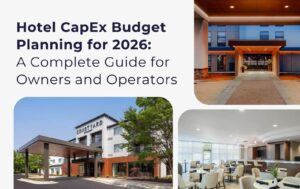Popularity and growth of extended-stay hotels have grown significantly over the last few years. Travelers have proven that they prefer these accommodations with high occupancy rates and hotels have shown that they’re listening to the wants and needs of guests.
Because of the flexibility that remote work, bleisure travel, etc. provides, today’s travelers are seeking places that help them balance their work and social life while also fulfilling their travel goals.
Many brands are embracing extended-stay hotels not only to offer guests comfortable places to work, live, and rest but also because of the return on investment this type of property offers. Longer stays typically equate to lower labor and operating costs.
What is an Extended-Stay Hotel?
Extended Stay hotels; also known as long-term stay hotels, provide guests with amenities and services that cater to longer stays (normally 5-7+ days). This is a cost-effective alternative to short-term renting apartments or townhouses. These hotels offer a “home-away-from-home” for businessmen, traveling medical professionals, people on extended vacations, and more. Extended-stay hotels offer the perfect blend of comfort, productivity, and living spaces for guests.
What is the Difference Between Traditional Hotels and Extended-Stay Hotels?
The main difference between a traditional and an extended-stay hotel is the price (including what guests are billed for), the function of the hotel and its operations, and often the amenities. Because guests are guaranteed to stay longer at extended-stay properties the average price per night will be lower than in a standard hotel where the price is higher because guests typically are not renting rooms for weeks on end.
What Amenities Are Typically Included in Extended-Stay Hotels?
Fully Equipped Kitchen or Kitchenette:
Kitchenettes including a refrigerator, microwave, stovetop or cookware, and utensils are typically provided to allow guests to prepare their own meals. Some higher-end properties may also include a dishwasher.
Separate Living and Sleeping Areas:
Many extended-stay hotel rooms are designed with separate living, working, and sleeping areas to provide more space, privacy, and create a more home-like feel.
Room design may include a sleeping area and living/eating area with a partition between the two, multi-functional workstations/entertainment centers that can be moved around depending on guests needs, comfortable, and modular furniture, outlets in furniture, kitchenettes, plenty of storage and shelving, blackout curtains and more.
Workstation:
A dedicated workspace with a desk and chair is typically provided in the room to accommodate guests who need to work during their stay.
Laundry Facilities:
On-site laundry facilities, such as washers and dryers, are commonly available, allowing guests to do their laundry without leaving the property. Higher-end properties or properties that want to stand out among the competition may offer in-room laundry facilities.
Complimentary Breakfast:
Many extended-stay hotels offer complimentary breakfast, often in the form of a continental breakfast or a hot breakfast buffet.
Fitness Center/In-Room Fitness Amenities:
A fitness center with exercise equipment is often available to help guests stay active during their stay, but more hotels have been leaning into wellness and offering rooms with exercise equipment in them.
Grocery Shopping Service:
Some extended-stay hotels offer a grocery shopping service, where staff can stock your kitchen with groceries for you.
Weekly Housekeeping:
Extended-stay hotels typically provide housekeeping services on a weekly basis rather than daily, helping to reduce costs.
Social Spaces:
Common areas, such as a lounge, courtyard, bar, and outdoor spaces where guests can socialize, eat or relax are typically provided.
Pet-Friendly Policies:
Many extended-stay hotels are pet-friendly, allowing guests to bring their pets for their extended stay.
On-Site Convenience Store:
Some extended-stay hotels have on-site convenience stores or markets where guests can purchase snacks, drinks, and essential items.
Shuttle Service:
Depending on the location, some extended-stay hotels may offer shuttle services to nearby business districts, airports, or other attractions.
Fun Fact!
Some luxury extended-stay hotels might offer more specific amenities like parking spaces, dog parks, on-site grocery or liquor stores, lounges, movie theaters, & 24/7 guest services.
Why Did Extended-Stay Hotels Become a Trend?
When the pandemic touched down in the United States in 2020, the remote work craze started and altered how people approach their “work from home” lifestyle. Hotels realized that if they wanted to keep business, they needed to adapt to what travelers would be most interested in.
Extended-stay hotels have not only gained popularity because of the pandemic, but also because of their cost-effective rates. Regular hotels are normally much more expensive per night, especially if you are staying for a long period of time. Extended-stay hotels often tailor their prices for lengthier stays. Typically the longer a guest stays, the lower the nightly rates go down.
What Are Guests’ Expectations When Staying at an Extended-Stay Hotel?
Because extended-stay hotels have become such a big trend since the beginning of the pandemic, hotels must figure out what travelers are most interested in when visiting.
Today’s travelers not only seek comfort and convenience during their stay but also are looking for unique experiences that make their trip memorable. Extended-stay hotels often incorporate local design and culture into their decor. This creates a sense of community within the hotel while also making it stand out within its market.
Brands Getting in on Extended-Stay
Almost all of the top hotel brands have been quick to adapt to the extended stay trend. Some of the top brands including Hyatt, Wyndham, Hilton, and Marriott have taken their own unique spin on the extended stay trend.
Hyatt Hotels announced in April of 2023 that they are opening a new brand of extended-stay hotels called “Hyatt Studios”. Hyatt’s primary motivation when opening this extended-stay brand was to ensure that guests could find a reliable extended-stay option, even if there were no other Hyatt Hotels in the area.
Wyndham also announced “ECHO Suites” in November 2022. Wyndham has said that the brand was created to help maximize effectiveness and reduce operating costs all while providing a “home away from home” option for long-term guests.
Hilton recently has announced they are adding an “apartment-style, extended-stay brand” called “Project H3”. One of the main focuses that Project H3 is trying to achieve with his new brand other than extended-stay is providing accommodations in strategic locations like close to hospitals, college campuses and military bases.
“StudioRes” by Marriott is the newest extended stay hotel brand announced out of the bunch. Marriott says that they intend this brand to be used for travelers and guests who are looking to stay for 20+ nights while also looking to only spend about $80 per night.
How to Convert your Hotel into an Extended-Stay Property
Extended-stay hotels offer cost-effective and more comfortable solutions for travelers staying somewhere long-term and converting a traditional hotel into an extended-stay hotel does not have to be as challenging as it sounds.
Are you looking to convert one of your traditional hotels into an extended-stay hotel?
Here’s a brief guide on how to achieve this:
Assessment and Planning:
The first step in transitioning into an extended stay property is conducting a thorough assessment of your existing hotel’s layout and infrastructure. Create a detailed plan that outlines the necessary renovations and design changes to accommodate extended-stay guests.
Obtaining PIPs from existing extended-stay hotels as references for necessary improvements can help in your renovation process.
Find the Right Contractor
Once you’ve determined which extended-stay hotel you’d like to convert to, consult with an experienced contractor to determine if your hotel is able to meet the requirements of extended-stay properties.
Finding a contractor who has experience in hotel renovations and conversions provides hoteliers with a huge advantage. Contractors who specialize in remodeling hotels understand and know the specific needs of hospitality renovations.
Room Redesign:
Modify guest room layouts to include fully equipped kitchens or kitchenettes with appliances, cookware, and utensils.
Create separate living and sleeping areas to offer more space, privacy, and create a home-like feel.
Incorporate modular and moveable workspaces with desks and comfortable chairs to cater to guests who may be working during their stay.
Further improve guest experiences with more outlets, smart room capabilities, comfortable and stylish furniture, blackout curtains, and increased storage such as added shelving.
Common Area Upgrades:
Review PIPs from extended-stay hotels to identify common area improvements. Typically these improvements include enhanced common areas, such as lounges and fitness centers. Consider adding outdoor grills and picnic areas for guests to enjoy outdoor meals.
Laundry Facilities:
Install on-site laundry facilities with complimentary washers and dryers to accommodate long-term guests’ needs.
Refer to the chosen PIP to ensure laundry facilities meet industry standards.
Technology Integration:
Upgrade internet connectivity to offer high-speed, reliable Wi-Fi for guests who may work or stream content. Include smart technology in rooms such as smart TVs, customizable lighting, and temperature settings, and furniture with outlets for charging devices in common areas and in rooms.
Accessibility Features:
Make necessary adjustments to accommodate guests with disabilities, including ramps, wider doorways, and accessible bathrooms.
Furniture and Fixtures:
Choose durable, high-quality furniture and fixtures that can withstand the wear and tear associated with longer stays while also ensuring that it is comfortable and reflective of the current design trends.
Soundproofing:
Invest in soundproofing to minimize noise disturbances, which can be a concern for extended-stay guests.
Energy Efficiency:
Upgrade lighting, windows, and HVAC systems to improve energy efficiency, reducing operational costs.
Interior Design and Décor:
Select interior design elements and décor that create a comfortable, homey atmosphere to make extended-stay guests feel more at ease.
Compliance and Regulations:
Ensure that all renovations comply with local building codes, zoning regulations, and accessibility standards. Before starting any renovations, give your hotel a walkthrough to make sure everything is up to code, working correctly, and is meeting all the requirements. Team up with your contractor and/or architect to ensure your hotel property’s renovation will go smoothly. Getting everything in order before renovations kick-off will allow for a much smoother process.
Project Management:
Employ experienced project managers or contractors to oversee the renovation work.
Use PIP cost estimates as benchmarks for budgeting.
Phased Renovation:
Consider conducting renovations in phases to minimize disruption to existing guests and maintain revenue streams during the transformation.
Conclusion
Renovating a traditional hotel into an extended-stay property requires careful planning, investment, and attention to detail to create a comfortable and functional environment for longer-term guests. Make sure the renovation work aligns with the needs and expectations of extended-stay travelers to provide them with the best possible “home away from home” experience.
Comparing PIPs from existing extended-stay hotels can provide valuable insights and best practices that help ensure your renovated hotel meets industry standards and guest expectations.
In conclusion, the popularity and growth of extended-stay hotels have significantly increased in recent years, driven by evolving traveler preferences, including remote work and a desire for more flexible, cost-effective accommodations.
As extended-stay hotels continue to thrive and evolve, hotel brands across the industry are joining the trend by creating their own unique extended-stay offerings. Converting a traditional hotel into an extended stay property is a strategic move, but with careful planning and a focus on delivering exceptional amenities and services, it can be a successful and sustainable endeavor that appeals to a wide range of travelers.




